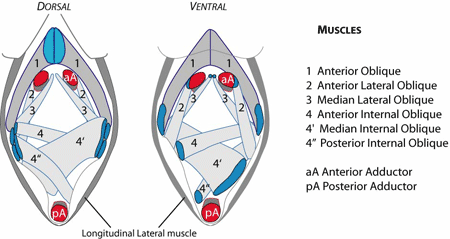 |
|
||||||
|
Genus Eolingularia Bitner & Emig, 2016 |
| [Type-species = L. siberica] - see figure below that belongs to the diagnoses of the species |
| Shell elongate-oval in outline, lateral margins subparallel, anterior margin broadly rounded. Valves weakly to strongly convex. Dorsal valve with posterior margin rounded, narrow median beak sometimes present, and a narrow internal central ridge extending over about 1 mm posterior to anterior oblique muscle scars. Ventral valve with triangular umbo formed by small to large internal propareas, continuous with posterolateral margins and separated by a deep pedicle groove; pair of narrow subparallel, V-shaped, grooves extends internally from the anterior adductor pair to posterior adductor where grooves join. Posterior adductor scar heart-like in outline. Main ventral and dorsal canals curved and convergent ante- riorly |
| Carboniferous-Triassic.
Occurrences: Russia, China, and Spain. Diagnosis from Bitner & Emig (2016) with complete description. |
|
|
-------------- ? Lingula subspatulata Hall et Meek, 1855? Lingula mytiloides Sowerby, 1813 ? Lingula ovalis Sowerby, 1855 and L. subovalis Davidson, 1852 |
|
Eolingularia siberica (Bitner & Emig, 1993) Lingula polaris Lundgren, 1883; Dagys, 1965. Diagnosis - (Biernat & Emig, 1993) Numerous fine radial striae and commonly concentric microlines between thicker growth lines generally visible on the shell. Umbonal region rounded on dorsal valve, pointed on ventral valve; small propareas separated by a deep and wide striated pedicle groove, not continuous with internal valve face. |
 |

